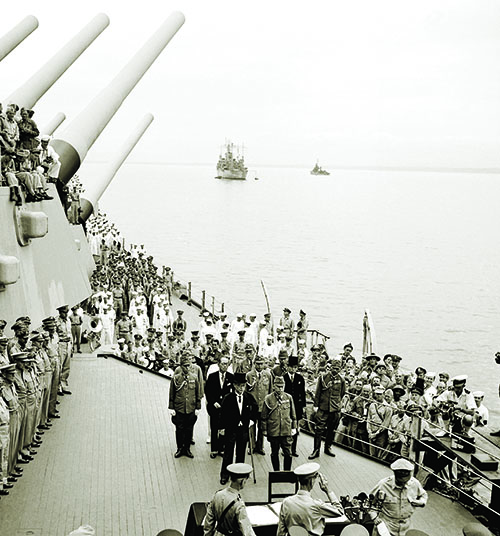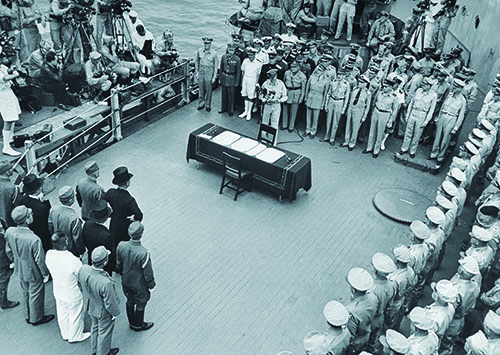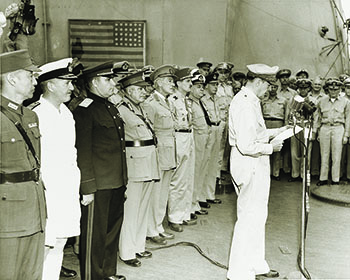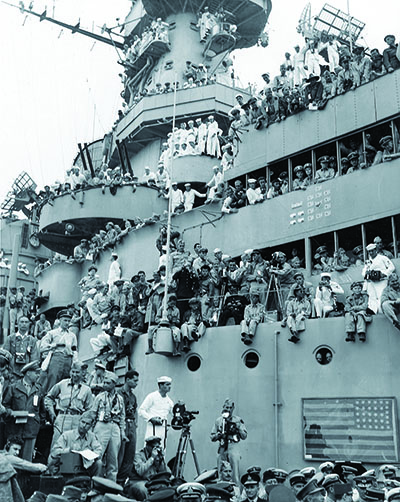
[dropcap]T[/dropcap]he striking images of the September 2, 1945, surrender ceremony aboard USS Missouri are among the most famous of the war. But they only tell part of the story. The ceremony combined meaning and symbolism—some of it intended, but most not—to create historical and political theater of the highest quality.
President Harry S. Truman ordered that the ceremony take place in public view in Tokyo Bay. What the president had not specifically factored in was that this action completed a circle begun four years earlier in another bay—Placentia Bay in Newfoundland—where on the decks of the American cruiser Augusta and the British battleship Prince of Wales, President Franklin D. Roosevelt and Prime Minister Winston S. Churchill committed their nations to the high principles of the Atlantic Charter, a joint declaration covering wartime conduct and the postwar order. Japan’s August 14, 1945, decision to surrender transpired four years to the day from the date the charter was issued. That joint declaration, moreover, had formed the template for the essential terms of Japan’s surrender: that the defeated aggressor nation would be disarmed, with the Allies seeking no territorial gains and the people of the defeated nation enjoying new freedoms.
Secretary of the Navy James V. Forrestal proposed that the Missouri serve as the site for the surrender ceremony. Truman enthusiastically made it official—partly for prosaic reasons. The huge battleship—displacing 45,000 tons yet capable of propelling its 887-foot length at 33 knots—was named after the president’s home state; his daughter Margaret had christened it. But the Missouri, flagship of Admiral William F. Halsey Jr.’s Third Fleet, also represented a stellar product of the “Arsenal of Democracy”—an arsenal the United States had shared generously and, at times, at great cost with its allies.
The scene at Tokyo Bay presented a staggering contrast to the German surrender at Reims, France, four months earlier. The surrender to the Anglo-American command transpired in a room in a school building, in the middle of the night. The timing and location of the surrender—not even on German soil—fit the vision of Supreme Allied Commander General Dwight D. Eisenhower, who did not want “a Hollywood show.” But the lack of representation of allies apart from the Soviets and the French provoked ire among other Allied nations. Individuals of high rank and prestige dominated the proceedings, while a small contingent of ordinary citizens in uniform was almost invisible in the dimly lit hall. Completely absent was Eisenhower. Still reeling from the horrific scenes he witnessed at German concentration camps, the general declined to attend, sending a representative in his stead.
In daylight, the vast expanse of Tokyo Bay teemed with 258 warships. Only one of them was a carrier—USS Cowpens, which owed its presence to the fact that Admiral Halsey’s daughter had christened it. The main carrier task forces stood vigil out to sea in case of Japanese treachery. Aboard the Missouri, on seemingly every available overlook, clustered “citizen sailors” in their whites, with a sprinkle of khaki-clothed Leathernecks from the ship’s Marine detachment. They were the proud representatives of all those in uniform who had overwhelmingly carried the battle to the face of the enemy and paid the highest price. They were there by right, not—as at Reims—by apparent sufferance.
The presence of those sailors and Marines as witnesses were all part of the ceremony’s careful composition. Truman had selected General of the Army Douglas MacArthur, the newly named supreme commander for the Allied powers, to conduct the ceremony. MacArthur’s chief of staff, Lieutenant General Richard K. Sutherland, and—particularly—Colonel Hervey B. Whipple, a logistics officer from MacArthur’s headquarters, meticulously planned its details in consultation with naval officers.
The Missouri’s captain, Stuart S. Murray, repeatedly rehearsed his crew to ensure that the ceremony would run without a hitch—even asking several young sailors to wear a mop handle strapped to one leg to better approximate the time required for Japanese foreign minister Mamoru Shigemitsu, who had a wooden leg, to make his way from the destroyer delivering the delegation to the veranda deck, where the surrender would occur.
Not everything, of course, went according to plan. The British had provided an elegant mahogany table for the signing of the instruments of surrender. It rested on the veranda deck beside the imposing structure of the forward main battery turrets, their trio of barrels raised no longer in menace but in salute. But when the documents arrived that morning, they were clearly too large for the table. Captain Murray summoned four nearby sailors, who impressed a simple mess table as a substitute, its humble origins concealed beneath a green baize cloth. The cloth was coffee-stained but, luckily, the documents covered the marks. This solution to the small crisis exemplified American talent for improvisation and a penchant for utility over ornate formality; some later praised the use of the table and cloth as a “beautiful common touch.”
As befitting the fact that the United States had not fought alone, high-ranking officers of its allies occupied a prominent position facing the table. These were representatives of China, Britain, the Soviet Union, Australia, Canada, France, the Netherlands, and New Zealand. They stood out with their formal uniforms adorned with gilt badges of rank and decorations as well as neatly disciplined ties and stiffly buttoned high collars. Scores of American officers of all services representing the joint warfare in the Pacific stood in loose ranks facing the table from the inboard side. In accordance with MacArthur’s express directive, they sported plain, open-collar khaki uniforms bearing only minimal rank insignia. MacArthur believed the officers should accept the surrender in the clothes they had worn to fight.
Mounted on a bulkhead overlooking the veranda deck was a glass case. It contained the American flag Commodore Matthew Perry flew in 1853 when he sailed into Tokyo Bay to initiate formal American relations with Japan—a symbol Admiral Halsey ordered transported by courier from the U.S. Naval Academy Museum. Perry’s ship had been anchored near that spot 92 years earlier; Captain Murray hung the flag where the arriving Japanese delegation was sure to see it.

Tight-lipped and glum, the formally attired delegation arrived punctually at 8:56 a.m., led by Shigemitsu, his gait wobbling. Shigemitsu lost his leg in Shanghai in 1932 to a bomb thrown by a Korean nationalist. Japan had fought the war claiming it sought the liberation of other Asian peoples, but Shigemitsu’s limp spoke otherwise. Amazingly, the foreign minister recognized among the Allied officers the physician who had saved his life in Shanghai—Colonel Lawrence M. Cosgrave, the Canadian representative. Shigemitsu almost smiled before he remembered the circumstances of his presence.
Then MacArthur strode to a cluster of microphones behind the simple table. Standing near him were Lieutenant General Jonathan M. Wainwright, who had surrendered Corregidor, and Lieutenant General Arthur E. Percival, who had surrendered Singapore. Both men had endured over three years of Japanese captivity. Their obviously emaciated appearance wordlessly exemplified some of the worst facets of Japan’s war.
MacArthur delivered one of the three greatest orations by an American in World War II—all connected to the Asia-Pacific War. One is Roosevelt’s immortal “Day of Infamy” speech on December 8, 1941; Roosevelt had paralleled Lincoln’s Gettysburg Address with the sublime virtue of brevity, and memorable cadence and phrasing. Another is a sermon by a Marine Corps chaplain, Rabbi Roland B. Gittelsohn, at the March 21, 1945, dedication of the 5th Marine Division Cemetery on Iwo Jima. There Gittelsohn looked down at black volcanic ash housing the remains of comrades and said:
Here lie officers and men, Negroes and Whites, rich men and poor, together. Here are Protestants, Catholics, and Jews together. Here no man prefers another because of his faith or despises him because of his color. Here there are no quotas of how many from each group are admitted or allowed. Among these men there is no discrimination. No prejudices. No hatred. Theirs is the highest and purest democracy.
Now MacArthur set his feet before the microphones and grasped in his slightly trembling hands a sheaf of papers that bore phrases crafted, like those of Roosevelt and Gittelsohn, by his mind alone. In a husky but firm voice, the general said:
We are gathered here, representatives of the major warring powers, to conclude a solemn agreement whereby peace may be restored. The issues, involving divergent ideals and ideologies, have been determined on the battlefields of the world and hence are not for our discussion or debate. Nor is it for us here to meet, representing as we do a majority of the people of the earth, in a spirit of distrust, malice, or hatred. But rather it is for us, both victors and vanquished, to rise to the higher dignity which alone fits the sacred purposes we are about to service, committing all our people unreservedly to faithful compliance with the understanding they are here formally to assume.
It is my earnest hope, and indeed the hope of all mankind, that from this solemn occasion a better world shall emerge out of the blood and carnage of the past—a world dedicated to the dignity of man and the fulfillment of his most cherished wish for freedom, tolerance, and justice.
MacArthur eschewed any blunt or veiled humiliation of the Japanese participants. He spoke not of surrender or defeat, but only of restoration of peace marked by freedom, tolerance, and justice. Toshikazu Kase, a Japanese foreign ministry representative who spoke excellent English, recalled that “MacArthur’s words sailed on wings” and the “narrow quarterdeck was now transformed into an altar of peace.”

MacArthur then summoned the representatives of Japan forward to sign the instrument of surrender, followed by Allied representatives. At 9:25 a.m., MacArthur declared, “Let us pray that peace now be restored and that God will preserve it always.” Facing the Japanese delegation he intoned: “These proceedings are closed.”
A massive fly-over had been choreographed to conclude the ceremony, but leaden skies seemed to prohibit it. However, the instant the ceremony ended, the clouds parted as if on divine cue. Under fresh sunlight, 462 B-29s and 450 carrier planes sounded a deafening final benediction.
And a blessing was in order.
By conservative counts, the Pacific War killed roughly 25 million human beings. About six million of these were combatants, including about three million Chinese and two million Japanese. That means a total of 19 million noncombatants died, a ratio of three noncombatants to one combatant. This is notably higher than the awful arithmetic for Europe, where about 1.5 noncombatants died for every one combatant. Of those 19 million, approximately one million Japanese noncombatants died from all causes. For every Japanese noncombatant who died, somewhere between 17 and 18 other noncombatants died—about two-thirds of them Chinese. This immense disparity in the death toll between Japanese and other Asians is understood in general terms, if not specifics, in China, Indonesia, Vietnam, and other Asian and Pacific nations, yet it remains mostly unknown among Americans.

The Pacific War arguably accomplished more to shape the twenty-first century than its European counterpart. In 1937 when continuous war began in China, the arc of Asia from India to Japan contained nearly half the world’s population but comprised just four
sovereign nations: Mongolia, Thailand, China, and Japan. The tides unleashed or reinforced by the Pacific War would create, in MacArthur’s words, “a basin…of a new emancipated world.” The end of war in that region spread independence, if not always freedom, to far more people than the European struggles from 1939 to 1945, and transformed the global order of the modern era.
Many minds had contributed to the lofty, symbolic design of the Tokyo Bay surrender ceremony, but it was the unintended symbolism, along with MacArthur’s capstone speech, that propelled it into a towering and enduring achievement. It proved a prologue to what would be MacArthur’s greatest role—a peacetime one—as the American tribune overseeing the occupation and transformation of Japan. ✯
This story was originally published in the October 2017 issue of World War II magazine. Subscribe here.





